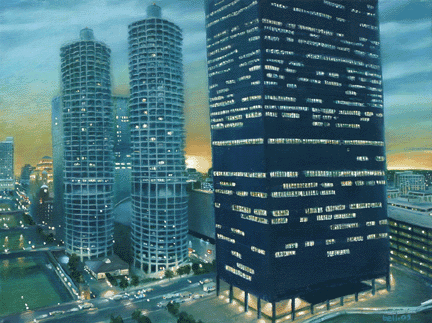Questions Never Posed, Investigations Never Made
Alex Starace visits the Random Strangers exhibition at the Rogue Buddha Gallery, another meditation on the nature of the city.


What does urbanism mean? Can we take action to counteract it? Do we even need to counteract it? …These are the sorts of questions you might expect to be addressed by the art at the “Random Strangers” exhibition at The Rogue Buddha Gallery in Northeast Minneapolis. The show, after all, was commissioned with the purpose of allowing six artists to “create original works … in order to express individual interpretations of urbanism.” However, an investigation of the resulting art reveals only a superficial treatment of the theme, as well as a series of limp, unremarkable aesthetic visions.
The strongest pieces of the exhibition are the photographs of Tim O’Toole, which feature images of abandoned, old, or obsolete buildings on the outskirts of urban Minneapolis. In his photo, Dine In (2005), he juxtaposes nicely an old hamburger joint, a modern billboard, trees, streetlights, and a purpling-blue late-evening sky. At its best, O’Toole’s work competently renders the detritus of a bygone era of handpainted signs, neon hope, and urban innocence. But O’Toole achieves little more than this and he seems aware of it: his photograph, (My) Nighthawks, is an explicit reference to Edward Hopper’s famous painting – but the reference only serves as a reminder of the superiority of Hopper’s work and of O’Toole’s dearth of originality.
In his artist’s statement about the series of photographs, O’Toole writes: “The buildings and locales are quite unremarkable. Pretty plain … Are these buildings/places historically significant?? Important?? No, probably not. But they are significant to me and that’s why I want to record them.” But O’Toole never describes why these buildings are important, nor does he demonstrate any awareness that his work should communicate to an audience; he creates bland images of buildings that are, in his words, “probably not” all that interesting – a self-involved diary of a photographer who’s yet to demonstrate his own aesthetic.
And this seems to be the problem with many of the pieces on display: the artists seem intent on navel-gazing, giving their work an onanistic, self-congratulatory air. As a result, much of the work comes across as ungenerous. Tighe Clark, in describing his video Nothing Like Being There (made in collaboration with Monty Nielson) says: “How often do you find yourself in an especially lucid moment . . . yet you find yourself imagining what the moment would be like written by your favorite author, or how your favorite actor would look portraying you? …My hope with the video is that I can feed myself enough self-reference that I’ll begin to subconsciously imitate my own life’s experiences, rather than unknowingly living out a Hollywood movie script.”
Throughout his artist’s statement, Clark expresses frustration at having his thoughts conditioned by the bombardment of art around him. Yet he makes a purely self-referential video and expects us to watch it? The question (and contradiction) that Mr. Clark never even attempts to answer is this: Why would we, as viewers, want our perceptions skewed by his art? And if he’s so frustrated because he doesn’t experience life first-hand, why is he in the art business at all? Shouldn’t he endeavor to go outside, meet people, go hiking, have a “real” life? His artist’s statement is so flimsy on logic that it never gets off the ground – and his video, while initially intriguing, ends up being a formless series of clips of randomalia, along with shots of a man running around New York City creating graffiti art. Exactly the sort of I’m-an-artist-so-I’m-making-this-personal-thing-you-have-to-be-interested-in art that audiences have understandably little patience for.
Or take a snippet from Jason Lemkuil’s artist’s statement: “The rigidity of the urban lifestyle provides a comfortable and secure path for those wishing to reach the American standard. / By looking at the basic principles of urbanism I attempt to extract the truth of our ways. We are pulled between what we need for survival and what we want. The decisions we make have a greater impact than the myopic view.” When looking at the entire text of Lemkuil’s awkwardly cryptic artist’s statement, his anti-consumerism and anti-stress sentiment is clear, which only serves to make his photographs all the more baffling. They’re large, glossy, perfectly square, and, in their way, quite good – they’re dead-on ringers of the over-colorful images one finds on nature calendars, or in business boardrooms above motivational slogans. His photo, Gates (2005), is taken in Central Park, NYC, and focuses on some snow-covered branches. In the background are the bright orange gates of Christo and Jean-Claude’s famous installation, making for a gorgeous dab of color in the midst of white picture plane.
Or see his Chairs (2005), which has deep green fir trees in the background and a series of lawn chairs perched on bright red rocks that (presumably) lead to a beach in the foreground. From his artist’s statement, it’s clear that Lemkuil wants us to see a striking contradiction between the human-made elements in his photos and the natural beauty he captures – however, a contradiction of precisely what is not clear. And so it doesn’t come off – the photos are simply really good calendar photos; no matter how much he wants us to believe they make a political statement about urbanism, they simply don’t -– at least not the statement he wants.
And, overall, the show “Perfect Strangers” suffers from this: none of the artists seem capable of making any incisive or intelligent commentary upon urbanism, nor do they have full control over their own aesthetic. The best pieces on display are average, while a few of the worst demonstrate an inadequate mastery of technique. All of which is a shame – “Perfect Strangers” is a decent idea for a show, even if it doesn’t end up succeeding.